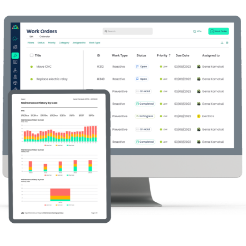
Manufacturing Downtime Explained: Common Causes and Fixes
In manufacturing, every second counts. When production stops, whether due to scheduled maintenance or an unexpected breakdown, it is referred to as manufacturing downtime. Planned or scheduled downtime includes activities such as preventive maintenance or changeovers, whereas unplanned downtime occurs unexpectedly due to equipment failures, power outages, or human error. Both carry a cost, but unplanned downtime is particularly disruptive. Why does it matter so much?
Downtime matters because it directly affects the bottom line. Each minute that production is not active leads to lost output, wasted labor, safety risks, and “damage” to customers’ trust. It also reduces productivity, disrupts workflow, and produces additional pressure on employees and equipment. It is essential to understand the primary causes of manufacturing downtime and to know how to address them effectively. This article examines the primary causes of manufacturing downtime and guides how to mitigate them.
The True Cost of Manufacturing Downtime
Downtime on a manufacturing floor is more than a pause in production; it's a critical impediment that sends shockwaves throughout an entire operation. While the immediate visual might be that of silent, stationary machinery, its impact cascades across the business, leading to significant financial losses, decreased productivity, and compromised customer satisfaction. Understanding the repercussions of downtime is critical for manufacturers to proactively identify and mitigate the issues that impact their operations. Ignoring the indicators or downplaying the severity of a brief halt can have long-lasting and detrimental effects, making it crucial for manufacturing businesses to develop strategies for prevention, detection, and rapid resolution.
Financial Impact - Lost Revenue, Hour by Hour
When machines stop, revenue stops too. A survey by ABB found that manufacturers lose about US$125,000 for every hour of unplanned downtime. This isn’t just about halted machines; it’s lost orders, wages paid for idle staff, and penalties for delayed delivery.
Operational Impact - Bottlenecks and Missed Deadlines
Downtime isn’t just expensive, it critically disrupts the entire operational flow of a manufacturing plant. A report by the industry highlights the staggering impact, indicating that large industrial establishments are losing almost 323 hours a month—an average of over 10 hours per day—solely due to machine failures and their ripple effects.
Downtime leads to a cascade of negative consequences that cripple productivity and profitability. Bottlenecks become inevitable, as production lines grind to a halt or operate at reduced capacity. This, in turn, causes severe schedule delays, throwing off production plans and delivery commitments. Teams are left in a perpetual struggle to catch up, often resorting to overtime and rushed work, which leads to further errors, increased operational costs, and diminished product quality. The cumulative effect is a significant reduction in overall equipment effectiveness (OEE), increased waste, and ultimately, a substantial financial hit for the organization. The unseen costs of damaged reputation, lost customer trust, and decreased employee morale also add to the negative impact of unchecked downtime.
Reputation Impact - Trust Takes a Hit
Customers don’t bother about your problems, but they certainly notice that their shipments are late. Repeated delays undermine trust, lead to contracts being annulled, and occasionally result in a loss of business that cannot be reinstated. An industry report noted that unscheduled downtime accounts for approximately 11% of annual revenues for the world’s 500 largest companies.
Industry Case in Point - Automotive Sector
In the automotive industry, downtime is costly. According to an industry survey, the automotive sector loses approximately $ 1.3 million per hour when operations are unexpectedly halted. That level of loss turns even minor disruptions into major financial setbacks.
Common Reasons for Manufacturing Downtime
The Equipment Failures and Breakdowns
Breakdowns are the closest thing to downtime and can affect machines of any age, whether it’s an overheating motor, a worn-out bearing, or a misaligned part that throws a wrench into the production gears. Failure typically begins at a small scale but can grow into expensive shutdowns. Regular inspections, lubrication, predictive monitoring, and operator training are key to prevention.
Aging Infrastructure & Obsolete Equipment
New machines can fail overnight, and older equipment is more prone to breakdown. Spare parts are far more difficult to find, repairs take longer, and obsolete control systems can't interface with current monitoring tools. Without exposure and support, this time-out gets extended beyond what is normal. The solution lies in phased upgrades, strategic retrofits, and maintaining critical spare parts to ensure resilience.
Human Error
Even in self-automated factories, mistakes made by technicians can halt production or cause machine breakdowns. This could be a result of poorly configured equipment, an overlooked procedure, or inadequate training. Standardized training, well-crafted SOPs, and digital work instructions reduce these types of mistakes. On-the-job training has workers excited about new technology, which is even better, with less downtime, increased efficiency, and enhanced safety.
Supply Chain Disruptions
The delay in raw materials can cause production to stop. Using digital monitoring allows real-time tracking and early intervention. Improving supply chains as part of production also helps to maintain smooth operations despite external interruptions.
Maintenance Related Downtime
Poor maintenance is a significant contributor to downtime. Ignored maintenance or untimely work costs production. Systems such as CMMS match maintenance to condition and schedules, eliminating downtime. Proactive maintenance avoids unplanned shutdowns and keeps productivity on track.
Utility and Power Outages
Power, water, or air loss causes the machines to stop immediately. Standby generators, UPS systems, and power management mitigate risk and safeguard equipment. Energy Resilience built into operations minimizes disruptions from utility outages.
Software or IT System Failures
Software like MES, ERP, and others manage manufacturing. Multiple processes can be interrupted due to system downtimes, network outages, or cyberattacks. For now, rigorous updates, redundancy, and integration of OT and IT ensure the system remains safe for continuous operation.
Changeovers and Setup Time
Switching to a new production method involves retooling, adjusting machines, and recalibrating, which can result in downtime. SMED on lean operations optimizes changeover, reduces setup time, and offers production flexibility.
Safety Incidents and Compliance Issues
Production stops immediately in the event of accidents or a regulatory check. Even minor incidents need to be reported, investigated, and followed up with corrective action that can ultimately result in significant costs. Regular training, including audits and digital compliance tracking, prevents stoppages and embeds safety as a routine.
Quality, Scrap, and Rework Issues
A machine breakdown doesn’t necessarily result in a stoppage of work. At other times, production is stopped because entire batches of products must be discarded or reworked after problems are discovered in them. Cause identification, process rectifications, and product rework waste time and resources. These are typically caused by low-grade materials, close tolerances, or incorrect deliverables issues, which lead to hidden downtime that can suck the life out of good performance.
Fixing Downtime - Strategies to Minimize Impact
Implement Preventive and Predictive Maintenance
One of the most effective ways to reduce downtime is through maintenance that goes beyond repairs. Preventive maintenance ensures that equipment is serviced, lubricated, and inspected regularly to maintain its optimal working condition.
Rather than waiting for a motor to burn out or a conveyor belt to seize up, predictive systems alert technicians with plenty of time to schedule repairs during scheduled downtime. This predictive system saves you both unscheduled downtime and secures the life of critical assets and machines. Manufacturing plants that invest in condition monitoring often report fewer breakdowns, faster response times, and greater confidence in hitting production targets.
Leverage CMMS for Smarter Maintenance Planning
CMMS software for manufacturing is a credible solution. With a CMMS, managers can assign tasks based on equipment priority, track progress in real-time, and ensure that nothing is overlooked.
The benefit goes beyond the organization. Digital checklists, compliance tracking, and automated reminders reduce the likelihood of human error while making preventive maintenance easier to plan. When maintenance activities are aligned with production schedules and supported by accurate data, downtime is no longer a surprise but a controlled part of operations. Manufacturing plants that adopt CMMS software often find they not only reduce unplanned stoppages but also improve consistency, efficiency, and overall equipment reliability.
Invest in Workforce Training and SOPs
Despite having the best machines and digitised tools, production can still face setbacks if workers have not been adequately trained. Downtime is often caused by human error, and the best way to prevent this is through a skilled workforce that knows about the equipment they are using, as well as production practices. Standardized operating procedures (SOPs) ensure that every task is carried out consistently, reducing the chance of mistakes that lead to stoppages.
Improve Supply Chain Resilience
Digital supply chain tools add another layer of protection by offering real-time visibility into shipments and allowing managers to predict delays before they cause stoppages. With better forecasting and more innovative inventory planning, manufacturers can maintain stable production lines even when external challenges arise.
Adopt Lean Manufacturing Techniques
Some of the most efficient ways to minimize downtime in your operation come from lean manufacturing itself. Workflow efficiency Kaizen, which focuses on constant and continual improvement, and SMED (Single-Minute Exchange of Dies) for rapid changeovers, are just a couple of key methods that can help improve workflows without wasting time.
When combined with data-driven insights from IoT sensors and AI analytics, these approaches allow the identification of inefficiencies and prompt swift action. The result is shorter setup times, smoother production flow, and fewer interruptions that lead to costly downtime.
Conclusion - Minimizing Downtime, Maximizing Outputs
Manufacturing downtime remains one of the most expensive obstacles in production, but it is not beyond control. While planned stoppages for maintenance are part of normal operations, unplanned downtime caused by equipment failures, supply chain delays, human error, and safety incidents drains productivity, increases costs, and damages customer trust. Recognizing these common causes of downtime is the first step toward effectively addressing them.
The solution lies in a proactive strategy. There are numerous practical means to reduce downtime, including predictive maintenance, more innovative scheduling with a CMMS, workforce training, resilient supply chains, and lean manufacturing techniques. By bringing these methodologies, manufacturers can convert downtime from a frequent interruption to a controllable and acceptable part of the business, thereby protecting efficiency and, in turn, competitiveness in the long run.
TABLE OF CONTENTS
Keep Reading
Tax season is the time of year that often sends a ripple of anxiety through many of us. The ...
11 Nov 2025
Selecting a Computerized Maintenance Management System (CMMS) can, at first glance, be an ...
4 Nov 2025
In healthcare facilities, equipment uptime involves more than achieving operational ...
31 Oct 2025
Companies are subject to economic ups and downs, also known as economic volatility. Today, ...
30 Oct 2025
Maintenance challenges are a constant struggle, with unplanned downtime costing manufacturers ...
27 Oct 2025
Last winter, a maintenance technician at a U.S. paper mill ignored a predictive alert that ...
10 Oct 2025
Many organizations proudly say they “have a CMMS,” but ownership alone doesn’t equal ...
9 Oct 2025
Every maintenance team is under pressure to do more with less. Unplanned downtime is often ...
7 Oct 2025
The implementation of simple, yet powerfully effective, checklists has repeatedly ...
3 Oct 2025
The increasing cost of maintenance, lack of accountability, and siloed systems leave many ...
30 Sep 2025
Preventive maintenance is one of those things maintenance teams know they need to do, but it ...
26 Sep 2025
Public services are essential to daily life. The provision of safe roads, functional transit, ...
25 Sep 2025
For most manufacturing facilities, a major focus of their maintenance teams revolves around ...
24 Sep 2025
Have you ever tried explaining to the CEO why the production line has been down for hours ...
18 Sep 2025
Over the past few decades, the hotel industry has undergone a dramatic transformation. ...
16 Sep 2025
Profitability is at the top of the list for manufacturing organizations when conversations ...
12 Sep 2025
Lean manufacturing is a goal that organizations strive for in their quest for operational ...
11 Sep 2025
In many organizations, the primary focus of maintenance work is on completing work orders, ...
9 Sep 2025
Word order backlogs are a reality that all maintenance and facilities management teams face. ...
5 Sep 2025
The critical nature of medical equipment has made maintenance management in healthcare ...
4 Sep 2025







